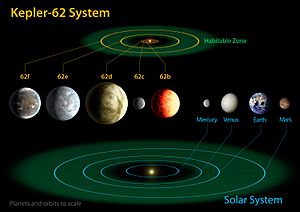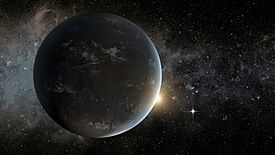Kepler-62f facts for kids

Artist's impression of the Kepler-62 system (sizes to scale) compared to the planets of the inner Solar System with their respective habitable zones.
|
|
| Discovery | |
|---|---|
| Discovered by | Kepler spacecraft |
| Discovery date | 18 April 2013 |
|
Detection method
|
Transit |
| Orbital characteristics | |
| 0.718 ± 0.007 AU | |
| Eccentricity | ~0 |
| 267.291 ± 0.005 d | |
| Inclination | 89.90 ± 0.03 |
| Star | Kepler-62 (KOI-701) |
| Physical characteristics | |
|
Mean radius
|
1.41 ± 0.07 R⊕ |
| Mass | 2.8+7.4 −1.6 M⊕ |
| Temperature | Teq: 208 K (−65 °C; −85 °F) |
Kepler-62f is a fascinating exoplanet that orbits a star called Kepler-62. It's known as a super-Earth because it's bigger than our planet but smaller than gas giants like Neptune. This exoplanet is special because it's located in its star's habitable zone. This is the area around a star where temperatures might be just right for liquid water to exist on a planet's surface.
The NASA Kepler spacecraft found Kepler-62f. It's about 990 light-years away from Earth in the constellation of Lyra. That's a very long distance!
Kepler-62f travels around its star at a distance of about 0.718 AU (107,400,000 km; 66,700,000 mi). This trip takes roughly 267.3 days. It's about 1.41 times larger than Earth in size. Scientists believe it could be a rocky or ocean-covered world.
Scientists are very interested in Kepler-62f because its star is calm and lives a very long time. This makes it a good place to look for signs of extraterrestrial life. The SETI program is even studying it!
Contents
What is Kepler-62f Like?
Size, Weight, and Temperature
Kepler-62f is a type of planet called a super-Earth. This means it has a radius and mass larger than Earth's. But it's smaller than the ice giants like Neptune and Uranus.
Its average temperature is about 208 K (−65 °C; −85 °F). This is similar to the temperature on Mars. Kepler-62f's radius is 1.4 times that of Earth. This size suggests it's likely a rocky planet with a solid surface. If it were much bigger, it might be a "mini-Neptune" with a thick, gassy atmosphere.
Scientists estimate its weight is likely around 2.8 times the mass of Earth, assuming it's made of rock.
Its Home Star: Kepler-62
Kepler-62f orbits a star called Kepler-62. This star is a (K-type) star, which means it's smaller and cooler than our Sun. Kepler-62 has a mass about 0.69 times that of the Sun and a radius about 0.64 times the Sun's.
Its temperature is 4925 K, and it's about 7 billion years old. For comparison, our Sun is 4.6 billion years old and has a temperature of 5778 K. Kepler-62 is also less bright than the Sun, shining with about 21% of the Sun's brightness.
You can't see Kepler-62 with your bare eyes. It looks very dim from Earth because it's so far away.
How it Orbits its Star
Kepler-62f takes 267.29 days to orbit its star. It's about 0.718 astronomical units (107,400,000 km) away from Kepler-62. This distance is similar to how far Venus is from our Sun.
Kepler-62f gets about 41% of the sunlight that Earth receives from the Sun. This amount of light is similar to what Mars gets.
Could Kepler-62f Support Life?

Scientists think Kepler-62f could be a planet covered in ocean with rock and water. This is because of its age (around 7 billion years), the amount of light it gets, and its size. Some studies even suggest that most planets of its size might be completely covered by water.
It might even have an exomoon! This is a moon that orbits an exoplanet.
What About its Climate?
Since Kepler-62f is the farthest planet from its star in its system, it might be very cold. Without enough carbon dioxide (CO2) in its atmosphere, it could be a planet completely covered in ice.
For Kepler-62f to have a climate like Earth's, it would need a lot of carbon dioxide in its air. This would help trap heat and keep the planet warm enough for liquid water.
In 2016, scientists at University of California, Los Angeles (UCLA) did studies on Kepler-62f. They found different ways the planet could be habitable. They looked at how thick its atmosphere might be and how much carbon dioxide it could have. They also considered different ways it might orbit its star. In 2018, more studies suggested that Kepler-62f might even have seasons, just like Earth!
Other Important Things
Kepler-62f is the outermost planet in its star system. This means that forces from other planets or its star probably haven't changed its tilt much over time. This is good because a stable tilt, like Earth's, helps spread heat around the planet. This could make it more suitable for life.
Stars like Kepler-62 can live for a very long time, much longer than our Sun. They are also calmer, which means they send out less harmful radiation. This makes them good stars to have planets in their habitable zones.
Scientists believe Kepler-62f, along with other exoplanets like Kepler-186f and Kepler-442b, are some of the best places to look for life beyond Earth.
How Was Kepler-62f Found?

The NASA Kepler spacecraft watched over 150,000 stars, including Kepler-62, from 2009 to 2012. It looked for tiny dips in a star's brightness. These dips happen when a planet passes in front of its star, which is called a transit.
At first, the Kepler team found three planets around Kepler-62. But a small error in their computer program caused them to miss Kepler-62f. Later, a professor named Eric Agol found three more transits that had been missed. These transits happened every 267 days. After more study, the Kepler team realized that a fourth planet, Kepler-62f, was causing these regular dips in light.
The discovery of Kepler-62f, along with other planets, was announced on April 18, 2013.
Looking Closer at Kepler-62f
Kepler-62f is about 990 light-years away. This is too far for our current telescopes to figure out its exact weight or if it has an atmosphere.
But new space telescopes are coming! Missions like TESS and CHEOPS will look at stars closer to Earth. Then, powerful telescopes like the James Webb Space Telescope and future ground-based telescopes can study these nearby planets. They will try to learn about their atmospheres, weights, and what they are made of.
Searching for Alien Life
Kepler-62f and the other planets around Kepler-62 are special targets for the SETI program. SETI uses radio telescopes to listen for any signals that might come from intelligent life in space.
If there were signals from Kepler-62f, they would have traveled for 990 years to reach us. As of 2016, no such signals have been found.
See also
 In Spanish: Kepler-62f para niños
In Spanish: Kepler-62f para niños
- Habitability of K-type main-sequence star systems
- Kepler-62e, another exoplanet in the Kepler-62 system
- List of potentially habitable exoplanets

